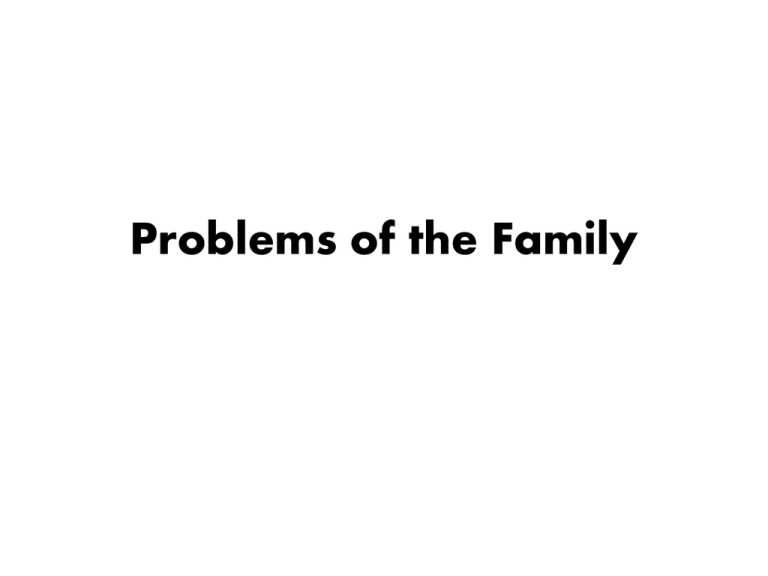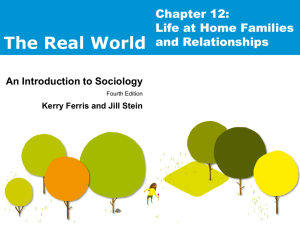
Problems of the Family
U.S. Families in Historical
Perspective
• Family arrangements are closely related to historical
economic developments.
– Industrialization and family arrangements
– The breadwinner/homemaker pattern never applied to
immigrants and racial minorities.
The Family in Historical
Perspective
• The “crisis of the family” argument
– Myth of a stable and harmonious family of the
past
– Myth of family decline as the cause of social
problems
The Family of the 1950’s
• The Traditional Family and the “natural order”
– The Industrial Revolution
– Women’s social status takes a step back
– Domestic Bliss and Housewife’s blight
• Did social problems such as marital instability, child abuse,
wife battering, and incest exist during the 1950’s?
The Current State of the Family
• The family has always undergone changes
– Women in the workplace
– Modern-day family stress
– Bankruptcy
• Why do most families go bankrupt
The Current State of the Family
• Other trends include:
– Higher divorce rates than 1950’s: Why?
– Increased singlehood (and delaying marriage) and
cohabitation: Why?
– Increased acceptance of homosexual couples:
More gay and lesbian couples raising children
– More single women having children
– More interracial marriages
– More women deciding not to have children
Today’s Diverse Family Forms
Opposing Viewpoints on the
Family
• The “Family Decline” Perspective- This view of the
family says that divorce, economic decline, and the
decline of two-parent intact families have hurt the
institution of family.
– Belief in a natural order for families
• The “Family Change/Resiliency” Perspective- This
view sees changes to the family as just that, changes.
Families are changing and adapting to new
environments. They are extremely resilient.
– The crisis of the family argument is not new. It is typical
throughout history and typical throughout the world.
Children: Our most precious
resource?
• Cross Cultural Comparison: The U.S invests very
little into the welfare of it’s children relative to
many industrialized countries
– The Human Capital Perspective: Reality vs popular
construction
– Child Care
– Child Poverty Rates
• Consequences
Capitalism Versus the Family
• The competitive free market and families
• Capitalism and “family Friendly” policies
• What rights and privileges are accorded to
people who are married or defined as family
by law?
• Is marriage and starting one’s own family a
goal of most Americans?
Same-sex Marriage
• The subjective nature of social problems
• The roots of prejudice
• The culture wars
– Legal soon? Why? How?
Divorce
• One in five marriages ends in divorce within 5
years.
• One in three marriages dissolves within 10
years.
– How does divorce affect men and women differently?
Children of Divorce
• 65% of all divorces involve children.
• One-third of White and two-thirds of Black
children will experience the divorce of their
parents by age 16.
• The large majority of children of divorce do
not experience severe or long-term problems.
Violence and Abuse
• IPV-Intimate partner violence
– Actual or threatened violent crimes committed
against individuals by their current or former
spouses, cohabiting partners, boyfriends, or
girlfriends
• What constitutes emotional abuse?
• Why doe most discussion of IPV focus on abuse of
woman?
Child Abuse
• Four categories of child maltreatment:
1.
2.
3.
4.
Neglect
Physical abuse
Sexual abuse
Emotional Abuse
• Incidence of Child Abuse
– In 2007, 794,000 substantiated cases of child
abuse and neglect
Causes of Child Abuse
• About 30% of people abused as children
become abusive parents.
• Chronic substance abuse by parents
• Poverty is the single best predictor of child
abuse and neglect.
• Unemployment and lack of social support
Factors contributing to IPV and family
violence
• Individual Factors
• Gender inequality and gender socialization
• Acceptance of corporal punishment
– Is it Ok to spank a child? Paddle?
• Inaccessible or unaffordable community services
– How do you prevent IPV and family violence?
• Cultural Factors
– Violence in the family stems from our society’s
acceptance of violence as a means of solving conflicts.






